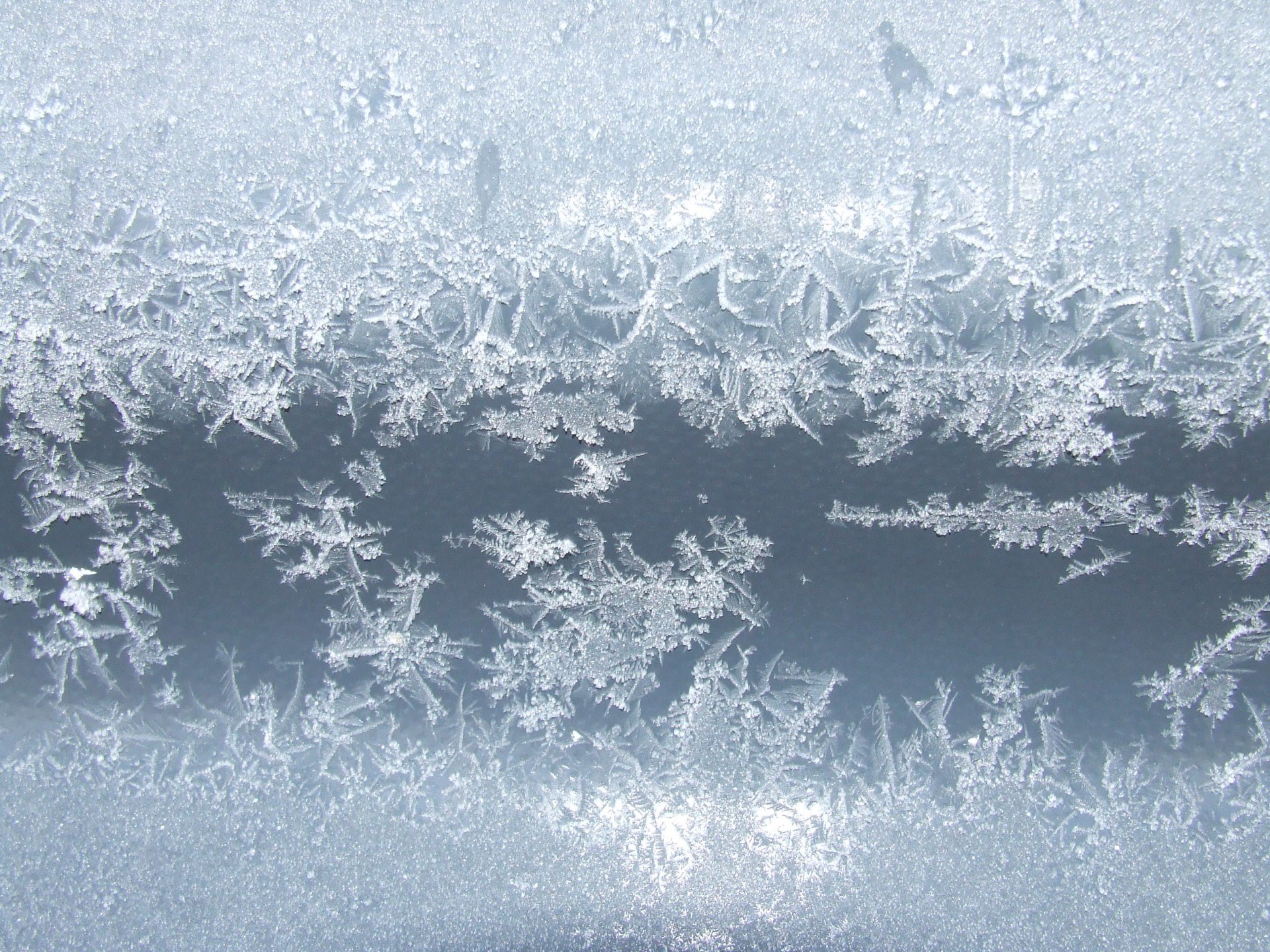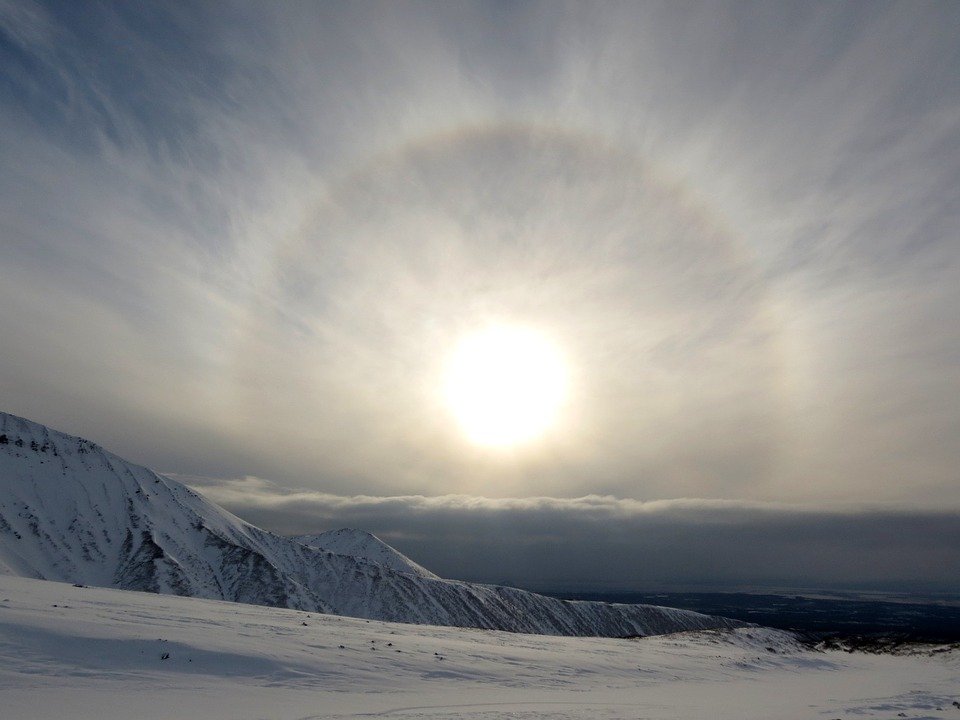Do you remember my story from yesterday's post (Diamond Rain In The Forest)? The beautiful rain of ice crystals called diamond dust? Do you want to know what other impressive optical illusions ice crystals can create? Then read on below.
 (Image source: publicdomainpictures.net)
(Image source: publicdomainpictures.net)
Diamond dust
In really cold temperatures (below 0°C) water vapor in the air near the ground does not condense to form droplets, but turns instantly to ice. This happens when the cold air above the ground mixes with the warmer air that's a bit higher. In such conditions hexagonal ice crystals form, those crystals hover above the ground and offer a magnificent sight refracting and reflecting the sun's light. [source]
From yesterday's post
Diamond dust resembles fog, only it's not vapor, but ice that floats above the ground. In temperatures below 0°C the humidity in the warmer air layers turns to ice when it meets the colder air near the ground and increases its relative humidity. Since ice crystals require the presence ice nuclei in order to start forming, the cleaner the atmosphere, the lower the temperature they need to form. In places with atmospheric pollution, dust or water droplets it's easier to see diamond dust at about -10°C, but in areas where there the air is clear, like Antarctica, your thermometer indication must be below −25°C.
Check again the video from yesterday:
When the hexagonal ice crystals are created, they refract and reflect the sunlight that hits on them displaying an array of wonderful other optical illusions like halos and sun dogs.
Let's recall what the terms refraction and reflection mean:
Refraction is when a ray of light enters a medium and bends (changes direction) but manages to pass through, remember prisms? Reflection is when a ray of light hits on a medium and bounces back (once again changes direction), like mirrors. When light hits on an ice crystal, some of it will be refracted and the rest will be reflected. The extend of these functions, the orientation of the crystals and the place where these happen will define the final optical illusion we'll see.
From "Bizarre Natural Phenomena Vol.29 - Natural Light Sabers (Light Pillars)", another illusion caused by ice crystals.
Halos, the ones that saints carry around their heads?
They look like these ones,but they are actually bright circles around the sun (or even the moon), usually spotted around 22° from it (but you can see halos at as far as 46°). And why 22°? It has to do with the refractive index of the ice (the indicator of how much does a beam of light "bend" when going through a certain material). For air the number is 1, but for ice the refractive index is 1.3 which means that the light beam bends once when entering the ice and once again when going out of it. The result is a rough 22° angle, although this depends on how the light beam hits on the crystals as well as the color of the light. These different angles sometimes create colorful, rainbow-like halos around the sun; and since the crystals are usually randomly arranged in the atmosphere, halos appear to be blurry and thick. Moreover, the crystals don't reflect light towards the inside of the halo, giving the illusion that the sky is darker around the inner rim.
 (Image source: pixabay.com)
(Image source: pixabay.com)
What's those sundogs you mentioned earlier? A new dog species?
No, sundogs are halos. They appear when the ice crystals, thanks to their aerodynamic shape, line up and float slowly horizontally, parallel, to the horizon and the sun is relatively low in the sky (at least that's when they are more visible). It's then that a sundog appears, which because of the crystals lining up and reflecting light in the same direction, turns out a more intense halo nearer to the ground on the left and the right of the sun. When the crystals are a bit bigger, they tend to get more easily disturbed by the atmosphere. They wobble and give taller sundogs and because the crystals' lining up is spoiled, light is reflected in more different angles, so the sun dog comes out blurrier.
 (Image source: commons.wikimedia.org)
(Image source: commons.wikimedia.org)
Another ice crystal illusion is the circumzenithal arc...
Circumzenithal arc? Does it involve any genitals mutilation?
Don't worry, it has nothing to do with genitalia, I assure you! Circumzenithal arcs are also created by ice crystals in angles greater than 46° above the sun, like a rainbow smile as big as a quarter of a circle. They form when the sun is low in the sky (altitudes lower than 32.2°) and they need the crystals to be lined up, so if there is any turbulence in the aatmosphere they cannot happen.
![]() (Image source: maxpixel.freegreatpicture.com)
(Image source: maxpixel.freegreatpicture.com)
Here is an episode of the SciShow on diamond dust and ice optical illusions, enjoy!
References
timeanddate.com/optical-phenomenon
wikipedia.org/Diamond_dust
wikipedia.org/wiki/Halo
wikipedia.org/Sun_dog
wikipedia.org/Circumzenithal_arc

Thank you very much for being here and reading this, I really appreciate your support and I'm always waiting for your views in the comments!
Recent posts from @ruth-girl:
* Bizarre Natural Phenomena Vol.35 - A Bouquet For The Snow Queen (Frost Flowers)
*A Fairy Tale Fairytale - Forest Magic (Short Story Of Fantasy)
* Greek Steemian Of The Week #13 & Mini Steemeet In Thessaloniki
* The Nikola Tesla Exhibition - The Man Who Invented The Future
* Trolls Around The Solar System (Part 2 - Venus)

Until my next post,
Steem on and keep smiling, people!



